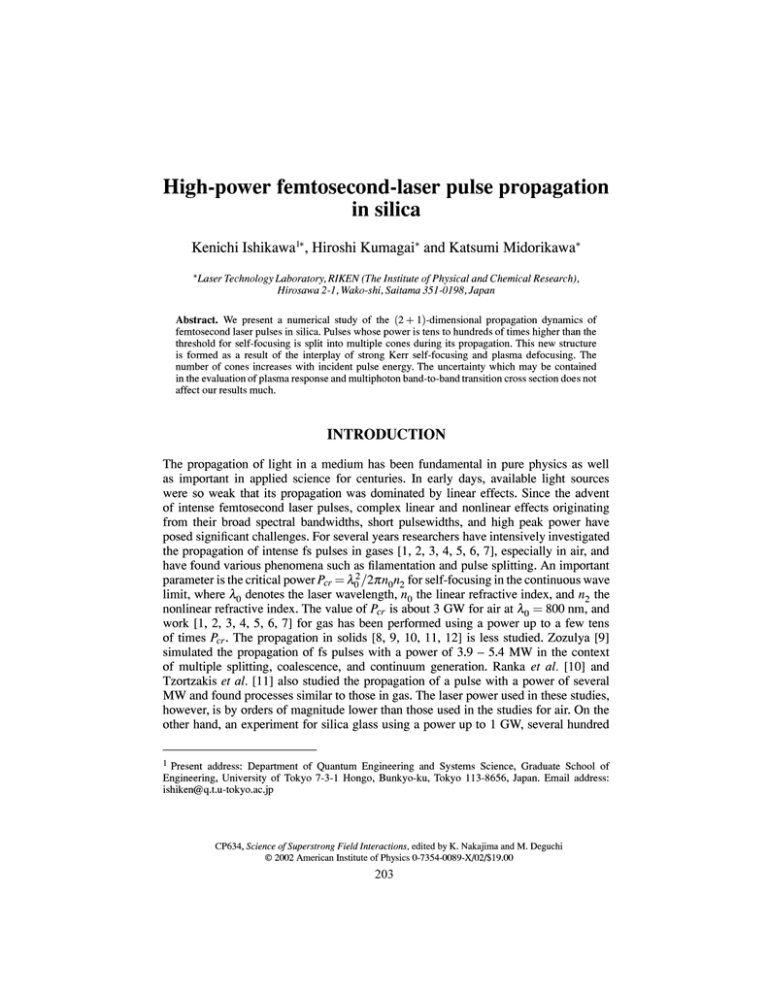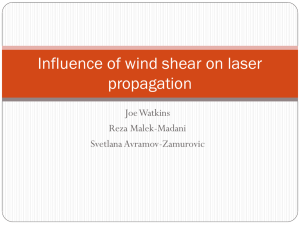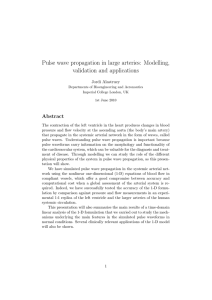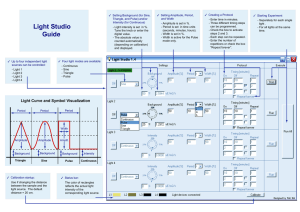High-power femtosecond-laser pulse propagation in silica Kenichi Ishikawa
advertisement

High-power femtosecond-laser pulse propagation in silica Kenichi Ishikawa1*, Hiroshi Kumagai* and Katsumi Midorikawa* *Laser Technology Laboratory, RIKEN (The Institute of Physical and Chemical Research), Hirosawa 2-1, Wako-shi, Saitama 351-0198, Japan Abstract. We present a numerical study of the (2+ 1)-dimensional propagation dynamics of femtosecond laser pulses in silica. Pulses whose power is tens to hundreds of times higher than the threshold for self-focusing is split into multiple cones during its propagation. This new structure is formed as a result of the interplay of strong Kerr self-focusing and plasma defocusing. The number of cones increases with incident pulse energy. The uncertainty which may be contained in the evaluation of plasma response and multiphoton band-to-band transition cross section does not affect our results much. INTRODUCTION The propagation of light in a medium has been fundamental in pure physics as well as important in applied science for centuries. In early days, available light sources were so weak that its propagation was dominated by linear effects. Since the advent of intense femtosecond laser pulses, complex linear and nonlinear effects originating from their broad spectral bandwidths, short pulse widths, and high peak power have posed significant challenges. For several years researchers have intensively investigated the propagation of intense fs pulses in gases [1, 2, 3, 4, 5, 6, 7], especially in air, and have found various phenomena such as filamentation and pulse splitting. An important parameter is the critical power Pcr = AQ jT.nn^n^ for self-focusing in the continuous wave limit, where A0 denotes the laser wavelength, /i0 the linear refractive index, and n2 the nonlinear refractive index. The value of Pcr is about 3 GW for air at A0 = 800 nm, and work [1, 2, 3, 4, 5, 6, 7] for gas has been performed using a power up to a few tens of times Pcr. The propagation in solids [8, 9, 10, 11, 12] is less studied. Zozulya [9] simulated the propagation of fs pulses with a power of 3.9 - 5.4 MW in the context of multiple splitting, coalescence, and continuum generation. Ranka et al. [10] and Tzortzakis et al. [11] also studied the propagation of a pulse with a power of several MW and found processes similar to those in gas. The laser power used in these studies, however, is by orders of magnitude lower than those used in the studies for air. On the other hand, an experiment for silica glass using a power up to 1 GW, several hundred 1 Present address: Department of Quantum Engineering and Systems Science, Graduate School of Engineering, University of Tokyo 7-3-1 Hongo, Bunkyo-ku, Tokyo 113-8656, Japan. Email address: ishiken@ q.t.u-tokyo. ac .jp CP634, Science of Superstrong Field Interactions, edited by K. Nakajima and M. Deguchi © 2002 American Institute of Physics 0-7354-0089-X/02/$ 19.00 203 times Pcr (= 2.2MW), was recently performed [12]. In the present study we report the results of our numerical simulations of the propagation of cylindrically symmetric intense fs laser pulses in silica in such a high-power regime. In this regime the laser pulse propagation is qualitatively different. After self-focusing, the pulse is multiply split in time as well as in space to form multiple cones. This structure originates from a large variation of the refractive index caused by nonlinear response of silica and plasma formation. MODEL Assuming propagation along the z axis, we model the evolution of the complex envelope E(r,z,f) of the electric field ^(r,z,r) = E(r,z,f)exp(/£ 0 z — icoQt) with the extended nonlinear Schrodinger equation [1, 7, 3, 4] in a reference frame moving at the group velocity, dz 2 2 dfl 6 3 dt* 2n0k0 \dr* r dr \ 6VFO HJ co0 dt £ E is normalized in such a way that \E\2 gives an intensity in W/cm2 for convenience, and c denotes the vacuum velocity of light. The second through fourth terms on the lefthand side describe the normal and third-order group velocity dispersion, and transverse diffraction, respectively. The terms on the right-hand side describe the nonlinear Kenresponse, the contribution of plasma formation to the refractive index, and loss due to multi-photon absorption. The terms containing an operator ^-Jy account for the correction beyond the slowly varying envelope approximation [8, 3, 4], necessary to treat short pulses considered in the present study. We choose a laser operating wavelength of A0 = 800 nm, which corresponds to the angular frequency 0)0 = 2.35fs~1 and the vacuum wave number &0 = T.SSjiim"1. The material parameters used in our simulations for silica are as follows: j8x = 4.894 jum^fs, /32 = 0.034, jim^fs2, n0 = 1.4533, n2 = 2.66 x 10~16cm2/W. The critical electron density pcr for A0 = 800nm is 1.74 x 1021 cm"3, and the initial electron density p0 in the valence band is 2.23 x 1022cm~3. p is the density of electrons produced through sixphoton band-to-band transitions (the band gap is 9.0 eV). The cross section (J6 for this process is evaluated to be 2.6 x 10~18055cm12 from the Keldysh theory [13]. Equation (1) is coupled with an equation describing the conduction electron density evolution, 204 In principle, a term for avalanche ionization should be added to this equation. The classical models [14, 15] of optical breakdown, however, cannot be applied in the fspulse regime [16, 17]. Although several new models [16, 17] have been proposed, their validity is yet to be established. On the other hand, no laser-induced damage was observed in the experiments by Kumagai et al. [12] under the conditions similar to those in our simulations. Moreover, in our results, the maximum intensity achieved during the propagation is much lower than the threshold for the laser-induced breakdown [18] as we will see later in Fig. 1, indicating that multi-photon band-to-band transition dominates plasma formation. We have, therefore, neglected avalanche ionization. The loss of electrons due to diffusion and recombination is also negligible in the fs regime [18]. The temporal intensity profile of the incident pulse is proportional to sech2 with a full width at half maximum (FWHM) of 130 fs. Its lateral profile is gaussian with a FWHM of 235.5jum. The geometrical focus is at a propagation distance z of 10.9 mm. The numerical scheme to solve Eq. (1) is based on the split-step Fourier method [19]. The diffraction term is treated with the Peaceman-Rachford method [20]. The nonlinear terms as well as Eq. (2) are integrated using the Runge-Kutta method. We have checked the numerical results by doubling the space and time resolution, which led to no significant changes in the behavior of the results presented here. We have also tried a few other integration schemes for Eq. (1) and confirmed that the results remain virtually the same. RESULTS AND DISCUSSIONS Evolution of the pulse profile Figure 1 illustrates the spatio-temporal laser intensity profile at different propagation distances z for the input energy of 135jiiJ. This translates to the input power P « 1GW or 4.7 x 102Fcr. By z = 3200jum, the pulse energy is concentrated near the beam axis due to self-focusing, and the peak is shifted toward the trailing edge due to self-steepening [19]. As the self-focusing proceeds and the local intensity increases further, conduction (plasma) electrons are produced through multi-photon absorption. Since the plasma formation has a negative contribution to the refractive index, this leads to defocusing near the trailing edge (z = 3300jum) and results in the formation of a cone-like structure (z = 3400/im). So far the pulse evolution is similar to those for the input power a few times higher than Pcr. What follows, however, is a dramatic new feature that emerges only when P exceeds Pcr by orders of magnitude. A second cone has been formed outside the first cone at z = 3500/im. With pulse propagation, more and more cones are formed, resulting in the formation of multiple-cone-like structure by z = 4000jiim. This structure is formed rapidly during a short interval of several hundreds of /im and propagates stably at least for 2 mm. The intensity achieved is at most 1.5 x 1013 W/cm2, and the maximum value of the fluence is 0.9 J/cm2. This is much smaller than the experimentally obtained threshold fluence for optical breakdown (30 J/cm2) for a 150-fs pulse [18]. 205 z = 3200 nm 200 0 100 0 -100 Time (fs) 3300 urn -200 3 6 Intensity (1012W/cm2 ) 100 3400 |j,m 0 -100 Time (fs) -200 100 Intensity (1012W/cm2) 0 -100 Time (fs) 3500 urn -200 100 0 -100 Time (fs) -200 5 10 Intensity (1012W/cm2) FIGURE 1. Spatio-temporal intensity distribution of an initially gaussian pulse with an energy of 135jU J propagating in silica at 8 different propagation distance z indicated above each image. The scale of vertical and horizontal axes is common for all the images. The gray-scale palette (a) of intensity applies for z = 3200jiim, (b) for z = 3300jtim, and (c) for the other values of z. Note that the distribution is cylindrically symmetric around the beam axis r = 0. To explore the mechanism of the multiple-cone formation, in Fig. 2 we show the lateral distribution of the laser-induced refractive index change An given by, (3) at t = 44fs and z = 3340 and 3360 jum, as well as the corresponding intensity distribution. It follows from Eq. (3) that the increase in intensity has a positive contribution, and the increase in conduction electron density, i.e., plasma formation has a negative contribution. In Fig. 2, at z = 3340jiim, the maximum in An is slightly outside the intensity maximum (i.e., the first cone), and An is nearly flat in the range r = 9 — 12 jum while the intensity gradually decreases with increasing r. These are because the electron density is higher for smaller value of r. At z = 3360/im, the self-focusing is so strong that the first intensity peak takes up much energy from its vicinity. As a result, the peak becomes more prominent, and a second local maximum in An is formed around r = 11.3/im. Once the second peak is formed, the local self-focusing effect leads to the grow-up of the second cone and to the formation of a third maximum in An. The avalanche of this process continues as long as the part of the pulse outside the outermost cone contains sufficient power. 206 t= —— •••••• —— ••••••••• intensity (3340|im) intensity (3360|im) An (3340fjim) An (3360um) 10 Radius r (um) 15 FIGURE 2. Radial distribution of intensity (thick lines, left axis) and refractive index change Aw (thin lines, right axis) at t = 44 fs. Solid lines are for the propagation distance z = 3340jum, and dotted lines for z = 3360 jum. (a) 45 uJ, z = 5500 |im (b) 15 uJ, z = 7000pm Intensity (1012W/cm2) FIGURE 3. Spatio-temporal intensity distribution of an initially gaussian pulse (a) with an energy of 45jiiJ at the propagation distance z = 5500 jiim and (b) with an energy of 15jtiJ at z = 7000 jiim. Figure 3 shows the spatio-temporal intensity distribution for the pulses with an incident energy of 15 and 45/1J at the propagation distance at which the multiple-cone formation is nearly saturated. With decreasing pulse energy, the number of cones decreases, and cones are more parallel to the propagation direction. Though not shown in Fig. 3, the multiple-cone formation ceases when we further decrease the incident pulse energy. Effect of the saturation of the electron drift velocity In Eq. (1) we have assumed a free-electron-like response of conduction electrons in silica. To our knowledge, no quantitative data are available on their response to intense laser fields. The electron drift velocity in a static electric field is proportional to the 207 field up to 2 x 105 V/cm with a mobility of 21 cm2/Vs [21], and much larger than the maximum velocity of a free electron oscillating in a laser field with the same strength. On the other hand, when the field is higher than a few MV/cm, the drift velocity is saturated at about 2 x 107 cm/s [21], i.e., the maximum free electron velocity in a laser field with an intensity of Ith = 1012 W/cm2. Above this intensity, the response of conduction electrons might be significantly different from that of free electrons. To examine the impact of this correction, we have performed simulations by replacing -£- in Eq. (1) with -£-f(\E\), where, J^=, (4) models the saturation of electron drift velocity in a simple manner. In Fig. 4 (a), we show the obtained intensity distribution at z = 4000 jum for the input energy of 135juJ. Although the cones are shifted toward the beam axis due to smaller plasma defocusing, the image is similar to the corresponding one in Fig. 1. Effect of the multi-photon absorption cross section Among the material parameters used in the present study, the value of <J6 is the most uncertain. The Keldysh theory may underestimate or overestimate the multiphoton ionization cross section even by two orders of magnitude. We have examined how the error in <J6 affects our results by simulating the pulse propagation with a hundred times smaller value of <76 (2.6 x 10~182,s5cm12). The result is shown for z = 3500 jiim in Fig. 4 (b). The difference from the corresponding image in Fig. 1 is again relatively small. The surprisingly small effect of the error in <76 is explained as follows: from the viewpoint of the band-to-band transition rate in Eq. (2) the decrease in (J6 is recovered by the increase in intensity only by \XlOO = 2.2. This does not affect the propagation behavior significantly. It follows from the preceding discussion that the qualitative features of the results presented in Fig. 1 do not depend on the details of the response and the production rate of conduction electrons. It is expected, therefore, that the essence of our results, especially the multiple-cone formation, probably holds for many other solids and liquids. Now we can divide the fs pulse propagation without breakdown into three different power regimes. In the low-power regime (P < Pcr) the propagation is predominantly linear. In the intermediate regime(F ~ several times Pcr), the filamentation and the temporal splitting is observed. In the high-power regime (P « several tens to hundreds of times Fcr), the multiple-cone structure is formed. CONCLUSIONS We have presented numerical simulations of the f s pulse propagation in silica in the highpower regime, where the power of the incident pulse is several hundred times higher than Pcr. The pulse is split many times both temporally and spatially, and, as a result, 208 (a) z = 4000 urn 200 100 (b) z = 3500 urn 0 -100 Time t (fs) 10 Intensity (1012 W/cm2 ) -200 Time t (fs) 15 0 10 20 30 Intensity (1012 W/cm2 ) FIGURE 4. Spatio-temporal intensity distribution of an initially gaussian pulse with an energy of 135/1J (a) at the propagation distance z = 4000 jiim obtained by taking account of the saturation of conduction electron drift velocity, (b) at z = 3500/im obtained with a value of (76 which is 100 times smaller than in Fig. 1. the intensity distribution contains multiple cones. The cones are formed rapidly within several hundred jiim by the interplay of Kerr self-focusing and plasma defocusing. The account of the drift velocity saturation of conduction electrons and the modification of the multiphoton band-to-band transition cross section do not affect our results much; the multiple-cone structure is formed in any case. This observation strongly supports the physical reality of this new feature. ACKNOWLEDGMENTS This work was supported by the Special Postdoctoral Researchers Program of RIKEN. REFERENCES 1. 2. Berge, L., and Couairon, A., Phys. Rev. Lett., 86, 1003-1006 (2001). Tzortzakis, S., Berge, L., Couairon, A., Franco, M., Prade, B., and Mysyrowicz, A., Phys. Rev. Lett., 86, 5470-5473 (2001). 3. Ranka, J. K., and Gaeta, A. L., Opt. Lett., 23, 534-536 (1998). 4. Rothenberg, J. E., Opt. Lett., 17, 1340-1342 (1992). 5. Mlejnek, M., Wright, E. M., and Moloney, J. V., Phys. Rev. E, 58,4903-4910 (1998). 6. Mlejnek, M., Kolesik, M., Moloney, J. V., and Wright, E. M., Phys. Rev. Lett., 83,2938-2941 (1999). 7. Akozbek, N., Scalora, M., Bowden, C. M., and Chin, S. L., Opt. Comm., 191, 353-362 (2001). 8. Christov, L P., Kapteyn, H. C., Murname, M. M., Huang, C.-P., and Zhou, J., Opt. Lett., 20, 309-311 (1995). 9. Zozulya, A. A., Diddams, S. A., van Engen, A. G., and Clement, T. S., Phys. Rev. Lett., 82, 14301433 (1999). 10. Ranka, J. K., Schirmer, R. W., and Gaeta, A. L., Phys. Rev. Lett., 11, 3783-3786 (1996). 209 11. Tzortzakis, S., Sudrie, L., Franco, M., Prade, B., and Mysyrowicz, A., Phys. Rev. Lett., 87, 213902 (2001). 12. Kumagai, H., Cho, S.-H., Ishikawa, K., and Midorikawa, K., unpublished (2002). 13. Keldysh, L. V., Sov. Phys. JETP, 20, 1307-1314 (1965). 14. Thornber, K. K., /. Appl. Phys., 52, 279-290 (1981). 15. Docchio, F., Regondi, P., Capon, M. R. C., and Mellerio, J., Appl. Opt., 27, 3661-3668 (1988). 16. Noack, J., and Vogel, A., IEEE J. Quantum Electron., 35,1156-1167 (1999). 17. Fan, C.-H., and Longtin, J. P., Appl. Opt., 40, 3124-3131 (2001). 18. Du, D., Liu, X., Korn, G., Squier, J., and Mourou, G., Appl. Phys. Lett., 64, 3071-3073 (1994). 19. Agrawal, G. P., Nonlinear Fiber Optics, Academic, San Diego, 1995, second edn. 20. Koonin, S. E., Davies, K. T. R., Maruhn-Rezwani, V., Feldmeier, H., Krieger, J., and Negele, J. W., Phys. Rev. C, 15,1359-1375 (1977). 21. Hughes, R. C., Solid-State Electron., 21, 251-258 (1978). 210






